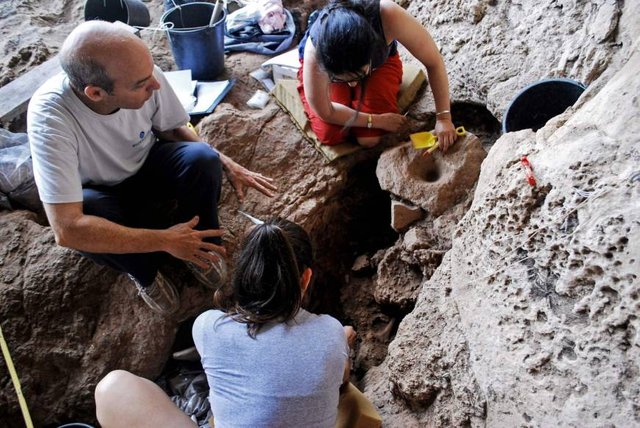
img src: wikipedia
In the Middle East, from before the end of the Pleistocene - what is called the Ice Age in the popular press - to around 7,000 BC existed a culture now called the Nafutian. This culture has been called both Mesolithic and Epipaleolithic. It transitioned form the paleolithic technological traditions to the Neolithic. They started as a hunter-gather culture and seemed to have transitioned into true agriculture. They largely lived in what is now Israel, Lebanon and Syria. At the time they lived there, the land was woodlands, rather than the scrub and desert of today. However, despite the climate of their time, the climate of ours makes it possible to find fascinating signs of how their culture evolved and interesting innovations in their cuisine.
The exact dates of this culture as somewhat blurred, not the least because, well, people involved! but also because we can only make guesses based on what we find. Like all things in the past, its likely the cultures probably existed prior to the first time we found their relics and probably after the last date we find them. Not everything is preserved. In paleontology, this is called the Signor-Lipps Effect. It matters more, in some ways, for mass extinctions, but also applies to other events recovered from the past.
The Natufian culture was interesting in many ways. They kept dogs: a puppy was found buried in a person's grave. They left grave goods, such as tools and ornaments. They liked to hunt gazelle, but not exclusively so. Their houses were set into the ground, being semi subterranean, probably to help insulate them. They used stone tools that seem to have some technological similarities to what was being done in North Africa, but based on genetics are a very distinct, local population. They were even distinct from the people who lived near them, including in Anatolia and the Zagros Mountains of Iran. Their transition to agriculture is probably one of the most interesting clues to the past of all. Especially their processing of grains or cereals.

img src: Mel's Kitchen Cafe
At a site called Shubayqa 1 in the Black Desert of Jordan, researchers from the University ofCopenhagen and University of Cambridge found evidence of bread. This bread dated from 14,400 years ago, prior to the end of the Pleistocene. It appears to have predated the Natufian adoption of agriculture. It predated most evidence of agriculture by four thousand years. The bread was made from oats, barley and wheat. The grains were ground, then sieved and then kneaded. The dough was then baked into something similar to unleavened flatbread.
In a way, this makes sense, why would you cultivate something unless you had a lot of uses for it? That bread may have preceded agriculture has some sense to it. Wild barley, oats and wheat were common in the area. As the climate changed, agriculture might have sprung up as just making sure your food source was near by and then some smart folks began growing the seeds of the varieties they liked best and then making sure they were properly watered and...etc, etc. However, there might have been another reason to make sure the grains were growing nearby: beer.

credit: AFP-JIJI
Researchers were digging in another cave, the Raqefet Cave in Israel, investigating the Natufian culture circa 13,000 years ago. This was still prior to the end of the Pleistocene. They found some mortars and pestles, stones and spots in stone used to grind up grain to make flour, etc. Much to their surprise, they found some of the mortars had been used to make alcoholic drinks from barley, wheat and oats. In fact, they found the locals had actually packed the ground up grains into the mortar holes to ferment. In effect, they had found evidence of, yup, beer.
How?
Like when you chew with your teeth and don't brush, the mortars were left with traces of what they were used for embedded in the stone. Do this a lot and some of the embedded material will last a long, long time because there was so much of it. (yes, seriously, brush your teeth...or don't, and make future archaeologists happy). In some of the mortars, they found the remnants of fermented cereals (grains). The recipe would probably not be almost anything like modern beer, but think of it as the cave beer. Rather different, primitive and...who knows about the taste.
This might have, however, helped make the Natufians (and probably other cultures) want to grow the cereal grains nearby. They could make bread...and get drunk. However, it ought to be remembered, too, that fermenting liquids also made them 'safe' to drink since most parasites and bacteria cannot survive the process. While it was probably not as much of a problem at that time, there have been periods in history where it was far, far safer to drink a beer than the water.

So raise a glass to the Natufians! And their ancient beer! It might have been one of the first, if not the first, alcoholic drinks in the world. And for you beer drinkers, be thankful and raise a toast.
Natufian culture
https://en.wikipedia.org/wiki/Natufian_culture
Mesolithic
https://en.wikipedia.org/wiki/Mesolithic
Epipaleolithic Near East
https://en.wikipedia.org/wiki/Epipalaeolithic_Near_East
Neolithic
https://en.wikipedia.org/wiki/Neolithic
Signor Lipps Effect
https://en.wikipedia.org/wiki/Signor%E2%80%93Lipps_effect
Archaeobotanical evidence reveals the origins of bread 14,400 years ago in northeastern Jordan
http://www.pnas.org/content/early/2018/07/10/1801071115.short
Archaeologists discover bread that predates agriculture by 4,000 years
https://www.eurekalert.org/pub_releases/2018-07/uoc--adb071118.php
Mortar and Pestle
https://en.wikipedia.org/wiki/Mortar_and_pestle
Drink to old times: World’s ‘oldest brewery’ found in Israel
https://www.japantimes.co.jp/news/2018/09/16/world/science-health-world/drink-old-times-worlds-oldest-brewery-found-israel/#.W56aFJNKjBI
Fermented beverage and food storage in 13,000 y-old stone mortars at Raqefet Cave, Israel: Investigating Natufian ritual feasting
https://www.sciencedirect.com/science/article/pii/S2352409X18303468
I don't like beer :( maybe that red Belgian beer "for girls" but not even that. Anyway, the story is cool. Welcome to steemSTEM community!
Downvoting a post can decrease pending rewards and make it less visible. Common reasons:
Submit
I don't drink either. However, the history of alcohol is interesting. It's like food: not everything ever made is something I want to eat. However, I am curious about it.
Downvoting a post can decrease pending rewards and make it less visible. Common reasons:
Submit
This post has been voted on by the steemstem curation team and voting trail.
There is more to SteemSTEM than just writing posts, check here for some more tips on being a community member. You can also join our discord here to get to know the rest of the community!
Downvoting a post can decrease pending rewards and make it less visible. Common reasons:
Submit
Hi @anzha!
Your post was upvoted by utopian.io in cooperation with steemstem - supporting knowledge, innovation and technological advancement on the Steem Blockchain.
Contribute to Open Source with utopian.io
Learn how to contribute on our website and join the new open source economy.
Want to chat? Join the Utopian Community on Discord https://discord.gg/h52nFrV
Downvoting a post can decrease pending rewards and make it less visible. Common reasons:
Submit
Is there any possibility that carbon dating or any other dating techniques could give wrong results? These dates are incredible!
Downvoting a post can decrease pending rewards and make it less visible. Common reasons:
Submit
Probably not.
There are older dates for some agriculture or "pre-" agriculture.
Archaeology and other scientific fields are constantly finding new things and, periodically, it changes how we view the world and our place in it.
Downvoting a post can decrease pending rewards and make it less visible. Common reasons:
Submit